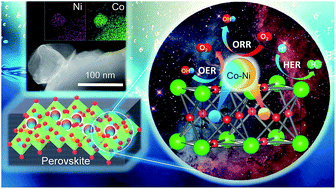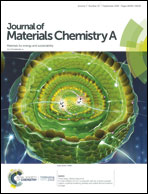Bimetallic nanoparticle decorated perovskite oxide for state-of-the-art trifunctional electrocatalysis†
Abstract
The development of stable ABO3 type perovskite oxides with trifunctional electrocatalytic activity is an arduous task. Such a feat is achieved by exsolution of the B-site cations to bimetallic nanoparticles (NPs) decorated on the perovskite surface. Sr0.95Nb0.1Co0.9−xNixO3−δ (0.1 ≤ x ≤ 0.4) was prepared by calcination at 1000 °C and treated under 10% H2/N2 to create <30 nm Co–Ni exsolved NPs. Oxygen evolution reaction (OER) and oxygen reduction reaction (ORR) activities are facilitated with x = 0.1 composition whereas hydrogen evolution reaction (HER) activity is boosted when x = 0.2. NP exsolution at 400 °C results in remarkable improvement in the activities such that the overpotentials drop by 58, 48 and 91 mV from their preceding parent compositions to 380, 347 and 208 mV at 10 mA cm−2, −3 mA cm−2 and −10 mA cm−2 for the OER, ORR and HER, respectively at pH 14. In terms of pH universality, HER overpotential is redressed to 183 mV at pH 0. The improved catalytic activity as compared to several reported perovskite oxide and non-perovskite based systems could be attributed to the simultaneous regulation of an optimal eg orbital filling, cation vacancies at catalytically active B-sites, lower metal–oxygen bond hybridization, oxygen non-stoichiometry, surface oxygen vacancies, and ionic and charge-transfer abilities.



 Please wait while we load your content...
Please wait while we load your content...